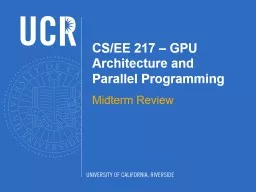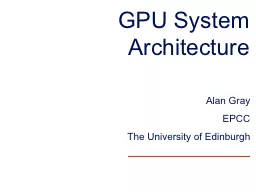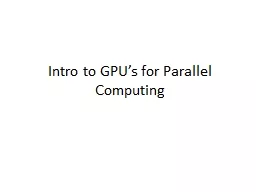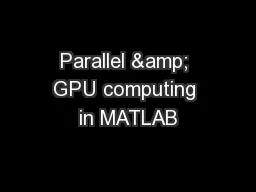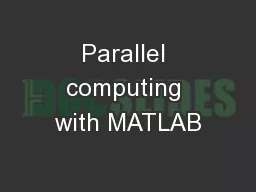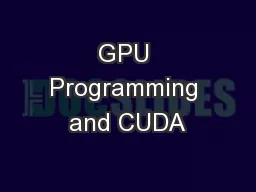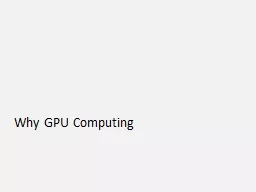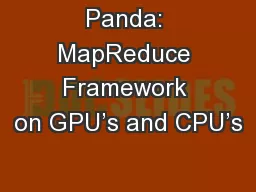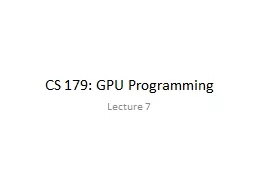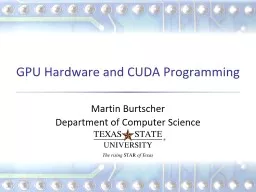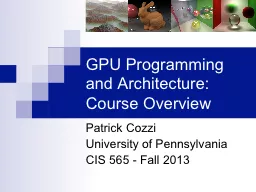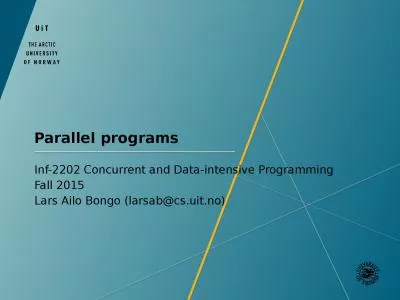PPT-CS/EE 217 – GPU Architecture and Parallel Programming
Author : faustina-dinatale | Published Date : 2019-06-25
Midterm Review Material on exam Module 110 Module 5 is mixed in there somewhere Chapters 36 8 and 9 Understand the CUDA C programming model Understand the architecture
Presentation Embed Code
Download Presentation
Download Presentation The PPT/PDF document "CS/EE 217 – GPU Architecture and Paral..." is the property of its rightful owner. Permission is granted to download and print the materials on this website for personal, non-commercial use only, and to display it on your personal computer provided you do not modify the materials and that you retain all copyright notices contained in the materials. By downloading content from our website, you accept the terms of this agreement.
CS/EE 217 – GPU Architecture and Parallel Programming: Transcript
Midterm Review Material on exam Module 110 Module 5 is mixed in there somewhere Chapters 36 8 and 9 Understand the CUDA C programming model Understand the architecture limitations and how to navigate them to improve the performance of your code . . Acknowledgement: the lecture materials are based on the materials in NVIDIA teaching center CUDA course materials, including materials from Wisconsin (. Negrut. ), North Carolina Charlotte (. Wikinson. Alan . Gray. EPCC . The University of Edinburgh. Outline. Why do we want/need accelerators such as GPUs?. Architectural reasons for accelerator performance advantages . Latest accelerator Products. NVIDIA and AMD GPUs. Goals for Rest of Course. Learn how to program massively parallel processors and achieve. high performance. functionality and maintainability. scalability across future generations. Acquire technical knowledge required to achieve the above goals. ITS Research Computing. Lani. Clough, Mark Reed. markreed@unc.edu. . Objectives. Introductory. level MATLAB course for people who want to learn . parallel and GPU computing . in MATLAB.. Help participants . Going Beyond Serial MATLAB Applications. MATLAB . Desktop (Client). Worker. Worker. Worker. Worker. Worker. Worker. Programming Parallel Applications (CPU). Built-in support. with t. oolboxes. Ease of Use. Sathish. . Vadhiyar. Parallel Programming. GPU. Graphical Processing Unit. A single GPU consists of large number of cores – hundreds of cores.. Whereas a single CPU can consist of 2, 4, 8 or 12 cores. Dr Susan Cartwright. Dept of Physics and Astronomy. University of Sheffield. Parallel Universes. Are you unique?. Could there be another “you” differing only in what you had for breakfast this morning?. Add GPUs: Accelerate Science Applications. © NVIDIA 2013. Small Changes, Big Speed-up. Application Code. . GPU. C. PU. Use GPU to Parallelize. Compute-Intensive Functions. Rest of Sequential. CPU Code. Hui. Li. Geoffrey Fox. Research Goal. provide . a uniform . MapReduce programming . model that works . on HPC . Clusters or . Virtual Clusters cores . on traditional Intel architecture chip, cores on . CS 179: GPU Programming Lecture 7 Week 3 Goals: Advanced GPU- accelerable algorithms CUDA libraries and tools This Lecture GPU- accelerable algorithms: Reduction Prefix sum Stream compaction Sorting (quicksort) Scientific Computing and Visualization. Boston . University. GPU Programming. GPU – graphics processing unit. Originally designed as a graphics processor. Nvidia's. GeForce 256 (1999) – first GPU. Martin Burtscher. Department of Computer Science. High-end CPU-GPU Comparison. . Xeon 8180M. . Titan V. Cores 28 5120 (+ 640). Active threads 2 per core 32 per core. Frequency 2.5 (3.8) GHz 1.2 (1.45) GHz. Patrick Cozzi. University of Pennsylvania. CIS 565 - Fall 2013. Lectures. Monday and Wednesday. 6-7:30pm. Towne . 307. Fall. and . Spring. 2012 lectures were recorded. Attendance is required for guest lectures. Fall 2015. Lars Ailo Bongo (larsab@cs.uit.no). Course topics. Parallel programming. The parallelization process. Optimization of parallel programs. Performance analysis. Data-intensive computing. Parallel programs.
Download Rules Of Document
"CS/EE 217 – GPU Architecture and Parallel Programming"The content belongs to its owner. You may download and print it for personal use, without modification, and keep all copyright notices. By downloading, you agree to these terms.
Related Documents

